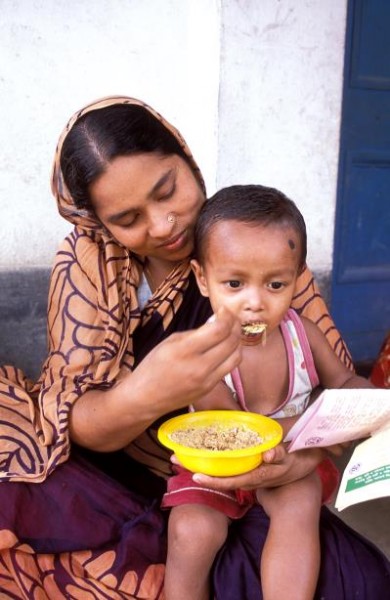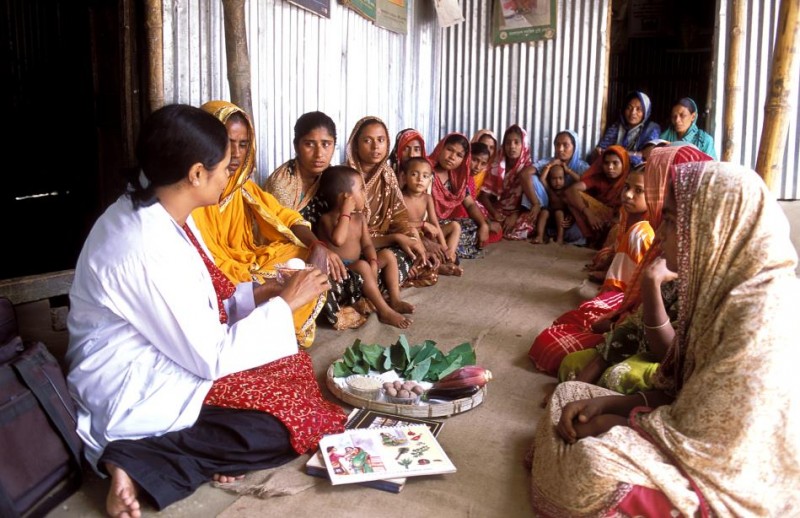Maternal education about complementary feeding increases height and weight gain in infants aged 6 months to 2 years.


Photos by: World Bank (Shehzad Noorani)
![]()
![]()
![]()
Why is complementary feeding important?
- Stunting and wasting (with intrauterine growth restriction) are responsible for about 21% of deaths worldwide in children under 5 years of age. The incidence of stunting is highest in children under two years old because of the high demand for nutrients and the lack of quality and quantity of available foods after exclusive breastfeeding.
- Complementary feeding refers to timely introduction of safe and nutritious foods in addition to breast-feeding (BF) at about six months of age. Two of the most commonly applied strategies to promote complementary feeding among mothers are the provision of appropriate complementary foods (with or without nutritional counseling) and maternal nutritional education to promote healthy feeding practices.
Does educating mothers about complementary feeding work?
- Children who received complementary food gained 0.25 kg and grew 0.54 cm over the study period.
- Complementary foods given with nutritional education for mothers resulted in weight gain of 0.30 kg and height gain of 0.49 cm in children 6 months to 2 years old.
Equity: Does it work in the disadvantaged?
- In developing countries, especially in food insecure populations, the provision of complementary foods (with or without nutritional counseling) is effective for increasing both weight and height in children 6-24 months of age.
Intervention Delivery
- The included studies provided food with and without nutritional counseling to caregivers. In food insecure settings, the provision of food with nutritional counseling for mothers was more effective than the provision of food alone.
- The most effective foods were micronutrient dense and diverse and included an animal source food.
Population and Setting
- All included studies were conducted in developing countries and included children between 6 months and 2 years old.
- Nutritional counseling was provided to mothers.
Summary of Findings [SOF] Table: Maternal education about complementary feeding and provision of complementary foods
Patient or population: Children aged between 6 months and 24 months
Settings: Children living in the community,
Intervention: Provision of complementary food (± nutritional counseling)
Comparison: No intervention
Outcomes | Anticipated absolute effects | No of Participants | Quality of the evidence |
Intervention vs. comparator mean difference (95% CI) |
|
| |
|
| ||
Weight gain (mean change in weight in kg) | 0.34 kg more1 (0.11 kg more to 0.56 kg more) | 3902 (11) | Moderate2 |
Height gain (mean change in length in cm) | 0.26 cm more1 (0.08 cm more to 0.43 cm more) | 3902 (11) | Moderate2 |
1 Weighted mean difference of 0.2 represents a small effect, 0.5 a moderate effect, and 0.8 a large effect.
2. High heterogeneity
Relevance of the review for disadvantaged communities Maternal education about complementary feeding increases height and weight gain in infants aged 6 months to 2 years. | |
Findings | Interpretation |
Equity – Which of the PROGRESS groups examined |
|
The review authors did not perform subgroup analyses by age, sex or socio-economic status. All studies were conducted in developing countries. Two studies provided the intervention only to malnourished children. | Depending on the design of the education and program, the effects of complementary feeding on height and weight will differ. The review did not examine the effect of complementary foods on subgroups of the population (ie. children up to one year and children over one year). |
Equity Applicability |
|
The review does not report on the effectiveness of delivery mechanisms for complementary feeding. However, in certain settings inclusion of complementary food is more effective than education alone. | The effects of these interventions were higher in food insecure than food secure populations. Those interventions that provided food with nutritional counseling were also more effective. Policy makers and practitioners will have to look at other study types to determine the most suitable delivery mechanism within the local setting. There is no universal package of components in which all possible effective complementary feeding interventions are integrated. Therefore it is difficult to generalize the impact of efforts to improve complementary feeding practices. |
The review summarized findings based on studies in which the level of organization may be higher than what is available outside of research settings. | Factors to consider when assessing whether the intervention effects are transferable to your settings include:
|
The included studies suggest that provision of complementary food is more effective in promoting growth in food insecure populations (GNI < 1$/day) compared to food secure populations (GNI >1$/day). Effect size was greater for weight gain and height gain. The studies included in this review demonstrate that educational interventions that emphasized feeding nutrient-rich animal-source foods had the largest effect. | Policy makers should choose to educate mothers about and provide complementary foods based on the availability of foods in their region. In certain areas, animal source protein could mean chicken and fish in countries like Peru, while eggs could be more readily available in other regions, like China. Economic context and affordability are important factors. |
Cost-equity |
|
The review did not report on the cost-effectiveness of complementary feeding education/provision. | The cost of educating mothers about and providing complementary feeding may be variable based on local conditions outside of research settings. Before implementing a complementary feeding intervention, policy makers should engage local community groups or community health care workers about whether this is a feasible program to add to their services. |
Monitoring & Evaluation for PROGRESS Groups |
|
In the studies reviewed, complementary feeding significantly improved the nutritional status of the children in the intervention group compared to control, with greater increases in height and length. | Providing complementary foods and nutritional counseling is recommended for mothers and caregivers of infants especially those in food insecure areas. |
The review evaluated the impact of provision of complementary foods with or without nutritional counseling and of maternal education alone. Both interventions were found to result in a significant increase in weight and linear growth. The combination of provision of appropriate complementary foods or the resources to procure them, with nutritional education is a key intervention that should be scaled up in developing countries. | Other studies are needed for policy makers and practitioners to make decisions on how complementary feeding might relate to other nutritional and health interventions. |
Comments on this summary? Please contact Jennifer Petkovic.
